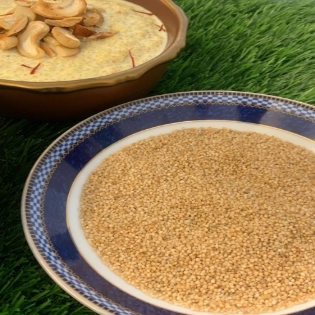LITTLE MILLET

Little millet is one of the smallest millets and is also called as kutki in Hindi, sava (Marathi), garjro (Gujarati). The Little Millet (Samai) is believed to have originated in India. In India, its cultivation is mostly confined to the the tribal belt of Madhya Pradesh, Chhattisgarh and Andhra Pradesh. It is grown and used for food almost exclusively in our country. It belongs to the group of small millets (other members being Proso, Kodo, Barnyard and Finger millets), which are said to be nutritionally superior to rice and wheat.
Nutritional Count Of Little Millet (100g)
- Energy - 314kcal
- Protein - 10.13 g
- Carbohydrates - 65.55 g
- Crude Fibre - 7.72 mg
- Calcium - 32.00 mg
- Iron - 1.30 mg
Rich In Antioxidants
- Little Millet is also rich in tannins, flavonoids which helps against diseases like diabetes, cardiovascular diseases, cataract, cancer, inflammation, Gastrointestinal problems and delay ageing too. Little millet is a nutrient-dense grain that includes minerals like magnesium, phosphorus, and iron, as well as dietary fibre, protein, and B vitamins (particularly niacin and thiamine). To add to its general health benefits, it is also a strong source of antioxidants. Little millet is a beneficial addition to a diet that is nutrient-rich and well-balanced because of the combination of these elements.
Rich Source Of Vitamin C And Minerals
- Corn is also a good source of vitamin C, a powerhouse vitamin that supports the wellbeing of our immune system as it combats fatigue, stimulates collagen and supports iron absorption. As vitamin C is sensitive to heat and can lose some of its properties during cooking, one of the best ways of cooking sweetcorn is by steaming it. Also found in sweetcorn is another B vitamin: thiamine (vitamin B1). Thiamine is responsible for breaking down our food turning it into energy as well as keeping the nervous system healthy.
Helps In Weight Management
- Little millet contains phosphorus which is great for weight loss, tissue repair and energy production after strenuous workout. It also helps detoxify the body. Little millet helps with weight management, improves digestion, supports heart health, and provides sustained energy due to its low glycaemic index. Due to high water-soluble fibre content, they provide satiety, prolonged gastric emptying and weight loss. Hence, little millet is recommended for people with lifestyle disorders like obesity, diabetes and other cardiovascular conditions
Helps Reducing Diabetes
- Little millet is known to be a low glycaemic index food and also high in dietary fibre. It takes longer time for glucose to enter the bloodstream and hence blood sugar levels remain stable. This effect proves beneficial for diabetics who have to control rapid rise and decline of blood glucose. Its low glycaemic index helps stabilise blood sugar levels and also supports weight management goals. Eating little millet can help with weight management, improve digestion, support heart health, and provide sustained energy due to its low glycaemic index.
Gluten Free
- Samai is gluten free. It is an excellent alternative for those opting for gluten free diet or those with celiac disease/ gluten sensitive enteropathy. Grain free of gluten, samai millet is high in antioxidants, minerals, and fibre. Little millets thus, make a perfect addition to the diet of people who do yoga, workouts, cardio, etc. Moreover, its high nutritional value makes it a must-eat in a balanced diet. It`s rich fibre, minerals, and vitamins, and it also helps regulate weight, blood sugar, and health. It`s gluten-free, so gluten-sensitive people can eat it. Moreover, little millet promotes sustainability through its cultivation practices, supporting biodiversity and food security.
High Dietary Fibre
- Little millet benefits also include its high dietary fibre content, which promotes digestive health. The fibre in little millet helps maintain regular bowel movements and prevent constipation. Additionally, it supports a healthy gut by providing bulk and aiding in the smooth passage of waste through the digestive system. Including little millet in your diet can contribute to a well-functioning digestive system and reduce the risk of gastrointestinal disorders. Little Millet's gluten-free nature lets you enjoy a variety of meals without sacrificing taste or nutrients. Dietary fibre aids digestion and reduces constipation.
- Little Millet is well-known for its nutritional advantages and is widely farmed throughout India. Grain free of gluten, samai millet is high in antioxidants, minerals, and fibre. It is frequently used to produce savoury porridges like upma and steamed rice cakes called idlis in traditional Indian cuisine. Samai millet has become more well-liked as a nutritious substitute for refined grains in a variety of culinary applications because of its high nutritional content and adaptability.


